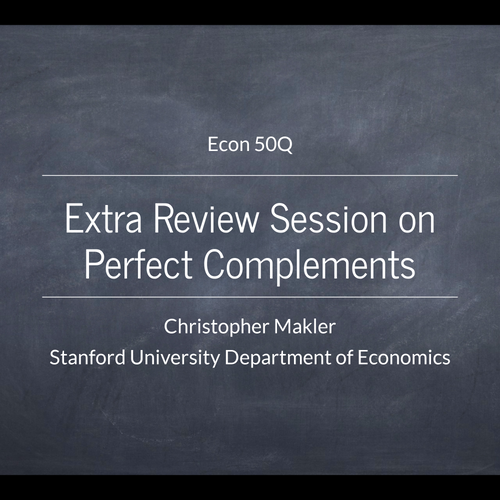Firm Production Functions and Cost Minimization
Christopher Makler
Stanford University Department of Economics
Econ 50 : Lecture 14
From Lecture I: Two Kinds of Optimization
Tradeoffs between two goods
Optimal quantity of one good
🍎
(not feasible)
(feasible)
🍌
Optimal choice
🙂
😀
😁
😢
🙁
🍎
benefit and cost per unit
Marginal Cost
Marginal Benefit
Optimal choice
Tradeoffs between two goods
Optimal quantity of one good
Checkpoint 1: October 13
Model 1: Consumer Choice
Model 2: Theory of the Firm
Checkpoint 2: October 27
WEEK 1
WEEK 2
WEEK 3
Modeling preferences with multivariable calculus
Constrained optimization when calculus works
Constrained optimization when calculus doesn't work
WEEK 4
WEEK 5
Consumer Demand
Application: Financial Economics
Checkpoint 3: November 10
Final Exam: December 12 (cumulative)
WEEK 6
WEEK 7
WEEK 8
Production and Costs for a Firm
Profit Maximization
Short-Run Equilibrium
WEEK 9
WEEK 10
Long-Run Equilibrium
Applications: Public Economics
Model 3: Market Equilibrium
Theory of the Firm
Theory of the Firm
Labor
Firm
🏭
Capital
⏳
⛏
Customers
🤓
Firms buy inputs
and produce some good,
which they sell to a customer.
PRICE
QUANTITY
Labor
Capital
Output
Firm
🏭
Costs
Revenue
Theory of the Firm
Firms buy inputs
and produce some good,
which they sell to a customer.
PRICE
QUANTITY
Labor
Capital
Output
Costs
Revenue
Profit
Next week: Solve the optimization problem
finding the profit-maximizing quantity \(q^*\)
The difference between their revenue and their cost is what we call profits, denoted by the Greek letter \(\pi\).
Theory of the Firm
Costs
Revenue
Profit
Theory of the Firm
Our approach will be to write costs, revenues, and profits all as functions of the ouput \(q\).
Profit
Theory of the Firm
Our approach will be to write costs, revenues, and profits all as functions of the ouput \(q\).
We will then just take the derivative with respect to \(q\)
and set it equal to zero to find the firm's profit-maximizing quantity.
MR
MC
Output Supply
Theory of the Firm
Finally, we will solve for a competitive (price-taking) firm's optimal output and inputs as functions of the price of output \((p)\) and inputs (\(w\) and \(r\)).
Profit-Maximizing Input Demands
Theory of the Firm
Exogenous Variables
Endogenous Variables
technology, \(f(L,K)\)
level of output, \(q\)
input prices \(w, r\)
Cost Minimization
Profit Maximization
cost function, \(c(w,r,q)\)
revenue function \(r(q)\)
Special Case: Competitive Firm
Exogenous Variables
Endogenous Variables
technology, \(f(L,K)\)
level of output, \(q\)
input prices \(w, r\)
Cost Minimization
Profit Maximization
cost function, \(c(w,r,q)\)
market price \(p\)
Friday
Monday
Wednesday
Firm Production Functions and Cost Minimization
Profit Maximization
Input and Output Decisions of a Competitive Firm
Unit III: Theory of the Firm
Week 6
Week 7
Checkpoint II
Cost Functions
and Cost Curves
Elasticity and Market Power:
From Monopoly to Competition
Monday
Checkpoint III
Week 8
RECORDED - NO LIVE CLASS
Today: Production Functions and Cost Minimization
Production Functions
The Firm's Cost-Minimimization Problem
(exactly like utility functions,
but the level matters)
(flipping the script on utility maximization)
Production Functions
A mathematical form describing how much output is produced as a function of inputs.
Labor \((L)\)
Capital \((K)\)
Production Function \(f(L,K)\)
Output (\(q\))
Isoquants
Economic definition: if you want to produce some amount \(q\) of output, what combinations of inputs could you use?
Mathematical definition:
level sets of the production function
Isoquant: combinations of inputs that produce a given level of output
Isoquant map: a contour map showing the isoquants for various levels of output
pollev.com/chrismakler

What happens to isoquants after an improvement in technology?
Marginal Products of Labor and Capital
Economic definition: how much more output is produced if you increase labor or capital?
Mathematical definition:
partial derivatives of the production function
These are both rates: they are measured in terms of units of ouptut per unit of input.
pollev.com/chrismakler

Consider the production function
What is the expression for the marginal product of labor?
Marginal Rate of Technical Substitution (MRTS)
Economic definition:
the rate at which a producer
can substitute one input for another
while keeping output at the same level
Visual definition:
slope of an isoquant
Mathematical definition:
we'll get to this in section and on Friday
Marginal Rate of Technical Substitution (MRTS)
Economic definition: the rate at which a producer can substitute one input for another while keeping output at the same level
Mathematical definition: slope of an isoquant
Recall: by implicit function theorem,
the slope of a level set is given by
Therefore the formula for the MRTS is
(absolute value)
Functional Forms
Examples of Production Functions
Linear
Leontief
(Fixed Proportions)
Cobb-Douglas
Constant Elasticity of Substitution (CES)
Examples of Production Functions
Linear
Leontief
(Fixed Proportions)
Cobb-Douglas
Constant Elasticity of Substitution (CES)
We will only be using Cobb-Douglas this quarter.
Cobb-Douglas Production Function
What story do these marginal products tell us?
When do these functions have diminishing marginal products?
Analyzing Production Functions Two Ways
Along an isoquant:
elasticity of substitution
Between isoquants:
returns to scale

Why do economists use different functional forms?
Elasticity of Substitution
- Measures the substitutability of one input for another
- Key to answering the question: "will my job be automated?"
- Formal definition: the inverse of the percentage change in the MRTS
per percentage change in the ratio of capital to labor, K/L - Intuitively: how "curved" are the isoquants for a production function?
CES Production Function
Returns to Scale
What happens when we increase all inputs proportionally?
For example, what happens if we double both labor and capital?
Does doubling inputs -- i.e., getting \(f(2L,2K)\) -- double output?
Decreasing Returns to Scale
Constant Returns to Scale
Increasing Returns to Scale
Does this exhibit decreasing, constant or increasing returns to scale?
Increasing returns to scale
pollev.com/chrismakler

When does the production function
exhibit constant returns to scale?
Production Functions and Utility Functions
Partial Derivative
Marginal Utility
Level Set
Isoquant
Slope of a
Level Set
Marginal Rate of Technical Substitution
MATH
UTILITY
PRODUCTION
Marginal Product
Indifference Curve
Marginal Rate of Substitution
Cost Minimization
Utility Maximization Subject to a Budget Constraint
Cost Minimization Subject to an Output Constraint
Conditional Demand Functions
Demand Functions
on \(q\)
pollev.com/chrismakler

If labor is shown on the horizontal axis and capital is shown on the vertical axis, what is the magnitude of the slope of the isocost line, and what are its units?
Cost Minimization: Lagrange Method
First Order Conditions
MRTS (slope of isoquant) is equal to the price ratio
Tangency condition: \(MRTS = w/r\)
Constraint: \(q = f(L,K)\)
Conditional demands for labor and capital:
Expansion Path
A graph connecting the input combinations a firm would use as it expands production: i.e., the solution to the cost minimization problem for various levels of output
Total Cost of \(q\) Units
Conditional demand for labor
Conditional demand for capital
"The total cost of producing \(q\) units
is the cost of the cost-minimizing combination of inputs
that can produce \(q\) units of output."
Exactly the same as the expenditure function in consumer theory.
Next Time
- Scaling production in the short run and long run
- Short-run vs. long run costs
- Cost curves
Econ 50 | Fall 25 | Lecture 14
By Chris Makler
Econ 50 | Fall 25 | Lecture 14
Production and Cost
- 86



